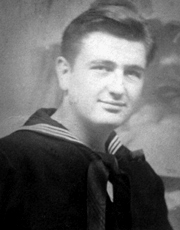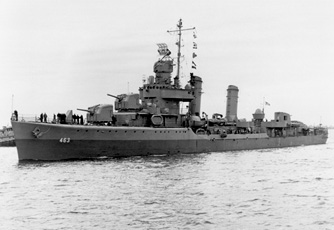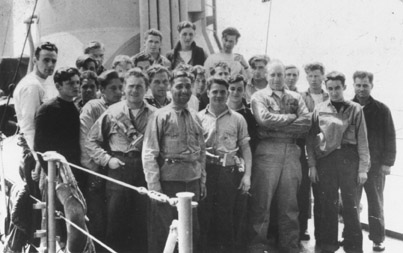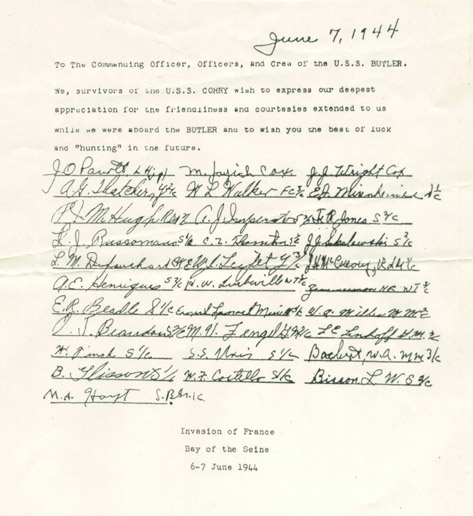
|

|
Matt Jayich
Boatswain's
Mate, USS Corry (DD-463)
I went aboard the Corry
DD-463 on a cold Wintery afternoon in Boston, Massachusetts on November 28,
1942. That was the night of the big fire at the Cocoanut Grove, 491 lives
lost. My life in the Navy was just starting to take me on a journey that I
was going to remember until the day I die. That also was the day I started
to grow up. I remember going aboard with a bunch of other apprentice seamen.
We were green as grass. The captain of the ship was Lieutenant Commander
Burchett, who was relieved on December 2, 1942 by Lieutenant Commander Lot
Ensey. After about a year, Commander Ensey was transferred and Lieutenant
Commander George Hoffman became the skipper. Commander Hoffman served as
captain until June 6, 1944.
June 6, 1944—that was the day the good ship USS Corry was sunk by German gunfire off the coast of France. That is the day I will remember all my life. The captain talked to the crew on the fantail in what you might call an orientation meeting in which he told us what we were to do and how we were going to do it. As I remember, we were to put two spar buoys in the water at a pre-determined distance, then we were to run figure-eights between the two buoys for a short time until the Germans fire what you call a "ladder" which is to fire before, after, beyond, and in front of the target to determine the proper range. Then they had you in the cross-hairs and opened up with all their guns at those pin-pointed X's. Believe me, the Germans were excellent marksmen. They got us while we were moving at a good clip and they continued to fire even after we broke in two. Then they fired anti-personnel shells above the men in the water. As I was told later, those shells burst and released white-hot phosphorous to rain down on you. While I was in the water I could feel the sizzle every time a piece of the material hit the water—pretty potent stuff.
What I remember happened to me on that day is as follows: Very early on the morning of June 6, 1944, as I looked out of Number 4 gun, which was my battle station, as a shellman, I saw the most beautiful sight I ever was to see in my life. There in the sky were, I guess, thousands of airplanes of all kinds, flying to France to drop their bombs to stop that madman Hitler and his armies. I was never in my life prouder than at that moment, to be an American, to be a sailor on an American man-o-war in the greatest task force in the world—with the feeling that we were the best and we would win this war. When we began firing, I threw those shells in as fast as I could. Later I found out that our gun put out 155 shells. I don't know how or who counted them but that was the word I got.
When we got hit and all the power went nuts, the gun was swinging from left to right and right to left several times before it hit the stops so hard it tore them off and went over. Our gun swung around and stopped after it hit the after deckhouse. The barrel was so hot from all the firing, I think the barrel was bent but I wasn't sure because the gray paint and the primer were both burned back quite a bit from the end of the muzzle. It may have been an optical illusion.
After the gun stopped, we climbed out onto the fantail. The Germans were still firing at us. The ship was heading toward shore and Mr. Vanelli, the executive officer, asked for someone to go into the after steering compartment to turn the ship seaward. I got two seamen, Padrick and Lynch, to go with me and try to turn the ship, but the rudder was jammed and we couldn't turn the helm. The word came down from top-side to try pumping the hydraulic pump that controls the helm. Padrick and I pumped while Lynch turned the helm. It was hard at first. Then the helm started to turn and we were able to turn the ship and top-side told us to come up, the job was done. When I came top-side, I lay down on the deck. I was tired after throwing all those shells and pumping the pump. The German shells were still landing all around us and Mr. Vanelli said we were to abandon ship so we capped the empty powder cases and threw them overboard to aid the men in the water to use as floats. Then we jumped in the water. The last thing I saw on the ship was Mr. Vanelli dropping his gun on the deck before he went into the water. I swam to a life raft and hung on to the side rope and right above me was seaman Henriques. His arm was hanging over the side and he had a compound fracture of the upper arm. He was in a lot of pain and needed a shot of morphine but the raft was upside down and the medical supplies were under the raft. I took out my case sheath knife and held my hand over the blade and I told the men around the raft not to kick under water because I was going under to cut the medical supplies loose so we could treat the injured men in the raft. That's when one of the men hanging onto the raft lost it. He started screaming that I was going to kill them from under the raft. He carried on so much that I just swam away. As I headed away from the raft I saw a shipmate from the engine room. He was calling for help. He was bleeding from the mouth, nose, and ears. I started to swim towards him when someone got hold of my shirt collar and stopped me, saying "Let him go, 'Boats' — he is gone and he could pull you with him." That has bugged me ever since. I wish I knew who that shipmate was. He just might have saved my life.
After a long time in the water, I was the last of thirteen men picked up by a whaleboat, the same one Mister Parrott (one of the Corry officers) was on. We were taken to the destroyer USS Butler (DD-636). When we got on board the Butler, we were almost sunk again, but the skipper of the Butler saw the "ladder" the Germans fired at us and realized they were doing the same thing to him. He gave the order flank speed astern. As we backed out at flank speed, a whole lot of shells landed where we had been. Thank God that skipper was on the ball and very alert. He saved us. The rest of the story is like all the others—we went to Scotland, then home on the Queen Elizabeth. This is the end of my D-Day story. I will never forget it.
Matt Jayich
Boatswain's
Mate
USS Corry (DD-463)

